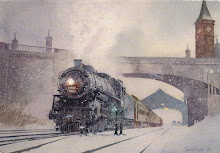 from the Small Endearments book. This crib quilt is from Maine, and was pieced in the last quarter of the nineteenth century. It is 39" X 41". I like to tell you what size it is to give you an idea of what size the blocks might be. This one runs a close second to the string quilt I showed on Friday one of my favorites..*VBS*
from the Small Endearments book. This crib quilt is from Maine, and was pieced in the last quarter of the nineteenth century. It is 39" X 41". I like to tell you what size it is to give you an idea of what size the blocks might be. This one runs a close second to the string quilt I showed on Friday one of my favorites..*VBS*I found it very interesting that both of my favorites(and a few others *G*) are in the Chapter called "Pieced for Pleasure". If you a regular reader of my blog, you totally understand why that chapter title would both appeal to and please me. Lining up on the other side of the quilt frame, across from the carefully pieced and mostly appliqued quilts of the early 19th century, the "pieced for pleasure" quilts stand tall. Manufactured fabric was becoming more readily available, as were patterns for specific blocks. Perhaps the maker of this quilt tried her hand at a new york beauty(or whatever) testing curved piecing but only made one or two blocks. Those charming orphans fit perfectly in a childs quilt.
Those quilters were aware of the "waste not, want not" commandment. And if you happen to be a quilt history fanatic, you probably know that those quilters used to pull the basting thread out in one long piece and wrap it around an envelope or spool and re-use it to baste another quilt. So many of my quilting friends laugh at that, but you either had to MAKE your tread, or buy it, and cash was in short supply. There is a referance in the Small Enchantments book about "unraveling a thread from the canvas cover" on the wagon, as that quilter moved west. She used those single threads to piece from her small bag of scraps, as she rode along the westward trail.
I've never suggest that any of us go to that kind of lengths. But it's good to be aware of the footprints you walk in, as you make YOUR quilts. Would we have the quilting tradition, here in America, if those brave ladies hadn't yearned to express themselves with the materials at hand? I don't think so. Wealth made it possible for the plantation owners to have exactly what they saw as beautiful and a possession. And they had the slave labor to get that accomplished. But thank goodness, the women slaves also had a need for self expression, and a real need for bed covers to keep their families warm. To me, that is the true spirit of scrap quilts and the quilting heritage I treasure.









.jpeg)































.JPG)






8 comments:
Love the strings and old quilt pictures, Finn. My grandma would save basting thread as you mentioned. She had a little nubbin of bees wax she would run her thread over so it wouldn't knot or tangle.
Hoping your eyes get better soon.
Thanks for the congrats at my place :)
love the "quilt for pleasure" -- the example you're showing today brought a smile to my face with the "split" blocks and discoradant colours/patterns
Like you I like these quilts alot. There is something very comforting in the organic feel to them, everything doesn't line up and "fly straight" :-)
You have wanting to find this book and thinking about making doll quilts. DIL is a day care teacher and she says they would come in handy in her school.
I vaguley remember my grandma saving a lot of her sewing supplies. I often wonder what my brother did with all of it. I'll never know.
Gosh, Finn, you always make us think...and think deeply. I am so grateful that I did a 'dumpster dive' at Community Quilting today. I was squaring off the edges of my quilt and just tossed the cut-off edge strip into the trash without even thinking. Then I looked down and realized that it might have only been 1 1/2" wide but it was many yards long...so in I went after it! I would have felt so guilty if I hadn't...especially after reading your post and the comments about the 'waste not, want not' philosophy of the early quilters. Today's narrow little scrap can be a heartstring for a new quilt tomorrow!
Finn - this also reminds me of Kantha quilts from India where they use the unravelled warp thread to make the stitches - my first mother in law was always careful to wind back the bobbin on the top of the sewing machine so as not to waste any thread - not sure what it did to her tension discs but it certainly saved thread
The scrappier the quilt the better as far as I am concerned! I love the utility quilts that used up every tiny inch of fabric. When we did a quilt documentation day in Georgia we got a lot of "salesman" sample quilts - my favorite was one done by a woman who ran a boarding house in the 1920's...the blocks were all wool and finished 2 inches by 4 inches and each block was different.
lovely to see you finishing ufos, on the dolly quilt wagon, and sharing some delightful "old" childrens quilts.
"pieced for pleasure", oh, I love that.
Post a Comment